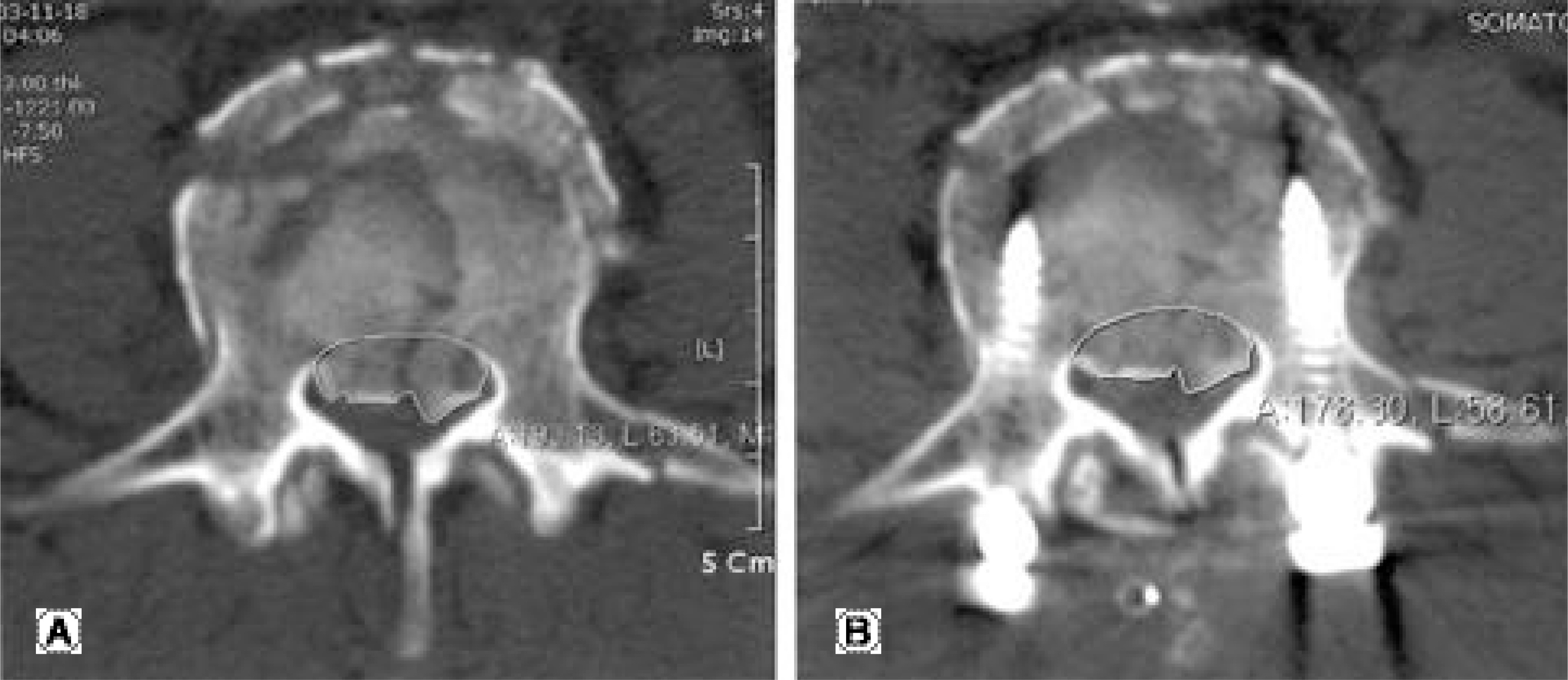J Korean Soc Spine Surg.
2006 Mar;13(1):10-15. 10.4184/jkss.2006.13.1.10.
The Effect of Pedicle Screw Instrumentation on Fractured Vertebrae in Unstable Thoracolumbar Burst Fractures with Canal Encroachment and Clinical Result
- Affiliations
-
- 1Department of Orthopedic Surgery, Gil Medical Center, Gachon Medical College, Incheon, Korea. dsjun@gilhospital.com
- 2Department of Orthopedic Surgery, Seoul National University Boramae Hospital, Seoul, Korea.
- KMID: 2040775
- DOI: http://doi.org/10.4184/jkss.2006.13.1.10
Abstract
-
STUDY DESIGN: A retrospective study.
OBJECTIVES
To evaluate the canal encroachment of fractured bony fragments and neurological deficits of pedicle screw instrumentation for the treatment of unstable thoracolumbar burst fractures with pedicle screws inserted into the fractured vertebrae.
MATERIALS AND METHODS
The authors evaluated 18 patients treated surgically with posterior fusions using pedicle screws for unstable thoracolumbar burst fractures, from March 2000 to September 2004. The ratios of the areas occupied by the fractured bony fragments in the canals were analyzed, before and after pedicle screw insertion, by computed tomography scans of the fractured vertebrae. The kyphotic angles, anterior vertebral heights, and neurological deficits were evaluated.
RESULTS
The areas occupied by the fractured fragments in the canals were improved significantly after surgery and there were no neurological complications resulting from the placement of pedicle screws or fragment displacements. The kyphotic angles and anterior vertebral heights at the last follow-up visits were improved significantly compared with the preoperative radiographs. The neurological deficits were not aggravated after pedicle screw insertion.
CONCLUSION
Our results suggest that pedicle screw instrumentation in fractured vertebrae is safe and effective for the treatment of unstable thoracolumbar burst fractures.
Keyword
Figure
Cited by 1 articles
-
Related Factors of Ligamentotaxis with Posterior Instrumentation for the Surgical Treatment of Thoracolumbar Bursting Fracture
Sang-Bum Kim, Taek-Soo Jeon, Seung-Hwan Kim, Han Chang, Cheol-Mog Hwang
J Korean Fract Soc. 2010;23(2):213-219. doi: 10.12671/jkfs.2010.23.2.213.
Reference
-
1). Huler RJ. Thoracolumbar Spine Fracture. Frymoyer JW, editor. The adult spine-principles and practice. 2nd ed.Philadelphia: Lippincott-Raven;p. 1473. 1997.
Article2). Knop C, Blauth M, Buhren V, et al. Surgical treatment of injuries of the thoracolumbar transition–3: Follow-up examination. Results of a prospective multi-center study by the “ Spinal” Study Group of the German Society of Trauma Surgery. Unfallchirurg. 2001; 104:583–600.3). Trivedi JM. Spinal trauma: therapy-options and outcomes. Eur J Radiol. 2002; 42:127–134.
Article4). Min HJ, Kim KW, Kim YH, Yoon US, Hwang JS. The comparison of loss of reduction at the thoracolumbar fracture according to insertion of screw including fractured vertebra or not in short segment posterolateral fusion. J Kor Spine Surg. 2002; 9:19–26.5). Doerr TE, Montesano PX, Burkus JK, Benson DR. Spinal canal decompression in traumatic thoracolumbar burst fractures: posterior distraction rods versus transpedicular screw fixation. J Orthop Trauma. 1991; 5:403–411.6). Fredrickson BE, Edwards WT, Rauschning W, Bayley JC, Yuan HA. Vertebral burst fractures: an experimental, morphological, and radiographic study. Spine. 1992; 17:1012–1021.7). Harrington RM, Budorick T, Hoyt J, Anderson PA, Tencer AF. Biomechanics of indirect reduction of bone retropulsed into the spinal canal in vertebral fracture. Spine. 1993; 18:692–699.
Article8). Kuner EH, Kuner A, Schlickewei W, Mullaji AB. Liga -mentotaxis with an internal spinal fixator for thoracolumbar fractures. J Bone Joint Surg Br. 1994; 76:107–112.9). Sjostrom L, Karlstrom G, Pech P, Rauschning W. Indirect spinal canal decompression in burst fractures treated with pedicle screw instrumentation. Spine. 1996; 21:113–123.
Article10). Boucher M, Bhandari M, Kwok D. Health-related qual -ity of life after short segment instrumentation of lumbar burst fractures. J. Spinal Disord. 2001; 14:417–426.11). Esses SI, Botsford DJ, Kostuik JP. Evaluation of surgical treatment for burst fractures. Spine. 1990; 15:667–673.
Article12). Alvine GF, Swain JM, Asher MA, Burton DC. Tre at -ment of thoracolumbar burst fractures with variable screw placement or Isola instrumentation and arthrodesis: case series and literature review. J Spinal Disord Tech. 2004; 17:251–264.13). Slosar PJ Jr, Patwardhan AG, Lorenz M, Havey R, Sartori M. Instability of the lumbar burst fracture and limitations of transpedicular instrumentation. Spine. 1995; 20:1452–1461.
Article14). McBride GG. Cotrel-Dubousset rods in surgical stabilization of spinal fractures. Spine. 1993; 18:466–473.
Article15). McNamara MJ, Stephens GC, Spengler DM. Transpedicular short-segment fusions for treatment of lumbar burst fractures. J Spinal Disord. 1992; 5:183–187.
Article16). McLain RF, Sparling E, Benson DR. Early failure of short-segment pedicle instrumentation for thoracolumbar fractures. A preliminary report. J Bone Joint Surg Am. 1993; 75:162–167.
Article17). Trivedi JM. Spinal trauma: therapy-options and outcomes. Eur J Radiol. 2002; 42:127–134.
Article18). Stephens GC, Devito DP, McNamara MJ. Segment al fixation of lumbar burst fractures with Cotrel-Dubousset instrumentation. J Spinal Disord. 1992; 5:344–348.
- Full Text Links
- Actions
-
Cited
- CITED
-
- Close
- Share
- Similar articles
-
- Spinal Canal Remodelling after Stabilization of Thoracolumbar Burst Fractures
- Change of Canal Compromise After Ligamentotaxis in Thoracolumbar Burst Fracture
- Relationship between Simple X-ray and CT Findings on the Degree of Canal Encroachment in Burst Fracture of Thoracolumbar Junction
- Fracture of Vertebral Body in Flexion-Distraction Injury of Thoracolumbar Spine
- Change of Kyphotic Angle in Posterior Pedicle Screw Fixation for Thoracic and Lumbar Burst Fractures: Comparison Study by the Screw Fixation Level



